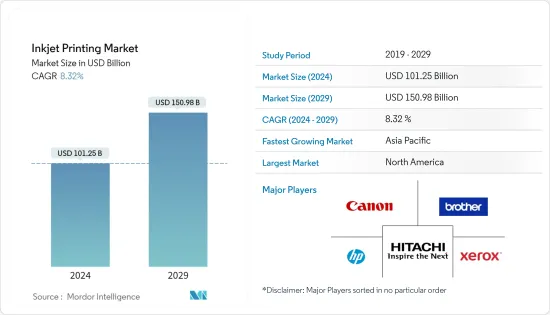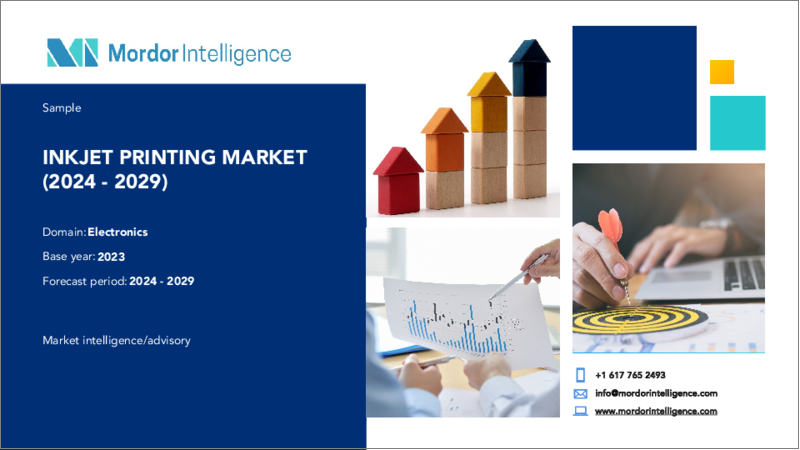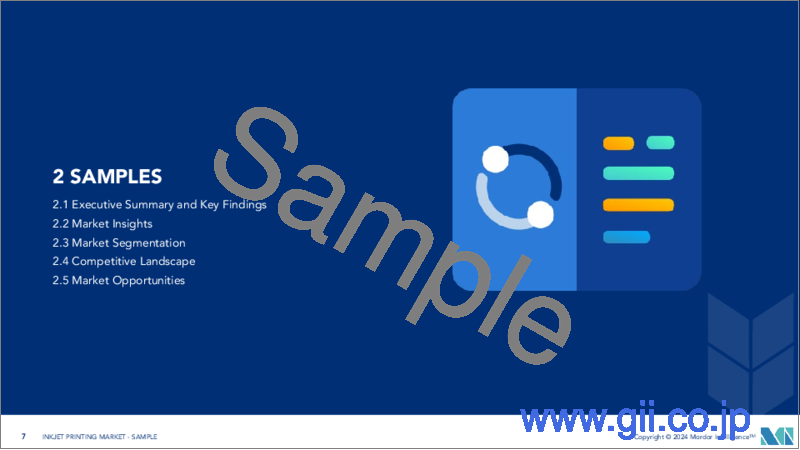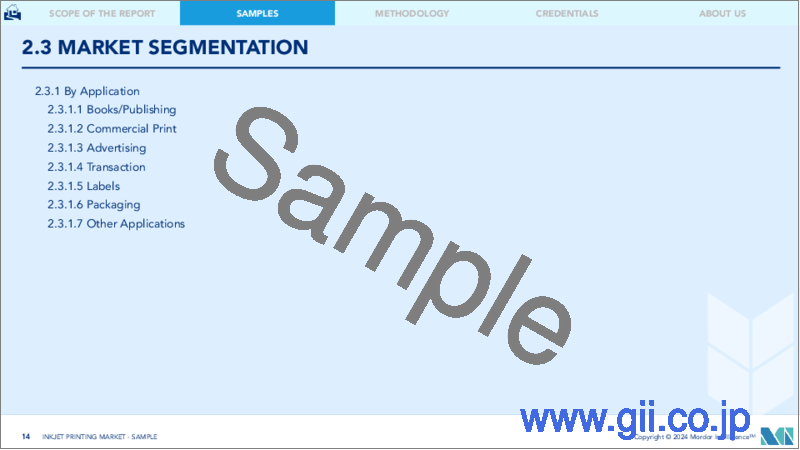|
|
市場調査レポート
商品コード
1438548
インクジェット印刷:市場シェア分析、業界動向と統計、成長予測(2024~2029年)Inkjet Printing - Market Share Analysis, Industry Trends & Statistics, Growth Forecasts (2024 - 2029) |
||||||
|
● お客様のご希望に応じて、既存データの加工や未掲載情報(例:国別セグメント)の追加などの対応が可能です。 詳細はお問い合わせください。 |
|||||||
| インクジェット印刷:市場シェア分析、業界動向と統計、成長予測(2024~2029年) |
|
出版日: 2024年02月15日
発行: Mordor Intelligence
ページ情報: 英文 125 Pages
納期: 2~3営業日
|
- 全表示
- 概要
- 目次
インクジェット印刷市場規模は2024年に1,012億5,000万米ドルと推定され、2029年までに1,509億8,000万米ドルに達すると予測されており、予測期間(2024年から2029年)中に8.32%のCAGRで成長します。

主なハイライト
- インクジェット印刷には、液体インクの小さな液滴を紙などの指定された表面にスプレーすることが含まれており、デジタル印刷の発展に役立ちました。この方法では、写真品質と同等の画像が生成されます。インクジェット印刷は、完全な多用途性と安価なセットアップコストを提供し、1部の少量印刷を可能にするため、他の印刷プロセスに代わる費用対効果の高い代替手段です。
- インクジェットを使用する主な利点は、小ロットでユニークな製品を効果的に生産できることです。 Web-to-Printテクノロジーによるオンライン注文と仕様の台頭により、商業印刷が前進しています。インクジェットプリンタの少量生産や1回限りの製品の生産能力は、このようなエコシステムにおける主要な実現者としての地位を確固たるものにしました。さらに、デジタル印刷の採用により企業がより柔軟に顧客の要件に対応できるようになるため、スマートな生産、スピード、柔軟性、コスト管理もインクジェット印刷の採用を促進し、インクジェット印刷市場の成長を促進します。インクジェットへの切り替えには潜在的な利点がもたらされますが、特にアナログ印刷と比較した場合、長時間印刷になると印刷コストが高くなるなどの制限もあります。
- インクジェット印刷業界はインクの需要を生み出すため、インクのエコシステムも進化すると予想されます。現在、溶剤系、水系、UV系インクが広く使用されています。一方、LEDインクは常に進化しています。ハイブリッド UV/ウォーターシステムが市場に登場しつつあります。一方で、インクのコストが高いことが依然として大きな問題となっており、その結果、アナログからデジタルへのベンダーの変換率が低下しています。予測期間中は、アプリケーションの増加と規模の経済により、インクの価格が下がる可能性があります。一方、インクのコストはアナログに比べて依然として高くなることが予想されます。
- 最近、デジタル広告メディアの人気が高まっており、印刷業界の成長に課題しています。メディアプレーヤーはデジタル広告にとって重要なコンポーネントであり、テクノロジー、ネットワーク接続、使いやすさにおいて急速な変革が起こっています。たとえば、デジタル広告メディアプレーヤーの米国プロバイダーであるBrightSign LLCは、2021年 5月に、従来のネットワーク接続方法では達成が困難なクラウドにメディアプレーヤーを接続するための新しいソリューションであるBrightSign Mobileを開始しました。このソリューションには、接続用のSIMカードがインストールされたUSBリージョナルモデムが含まれています。これらの開発と革新は市場の成長をさらに抑制しました。
- 食品および医薬品の包装の需要が高まっているため、包装、ラベル、印刷部門はCOVID-19期間においてかなり安定しています。しかし、新型コロナウイルス感染症(COVID-19)の発生により、食品、飲料、ヘルスケア、産業などのさまざまなエンドユーザー業界にわたるサプライチェーンが混乱しました。パンデミックは経済に多大な影響を及ぼしましたが、インクジェット印刷会社は、要件を満たしている企業にWeb-to-Print技術を使用して新型コロナウイルス関連の印刷広告を提供することで、この要件を満たしています。これらは、COVID-19感染症のパンデミックに関するすべての企業顧客の問題を伝達するために使用されます。
インクジェット印刷市場動向
広告は市場で圧倒的なシェアを握ると予想される
- 広告は販売時点情報管理(POS)とディスプレイを構成し、最も急成長しているセグメントの1つと考えられています。ソフトサイネージは、デジタル印刷された布製サイネージを表すために使用される一般的な業界用語です。ソフトサインは特定のインクセットに限定されていますが、通常はポリエステルベースの布地に印刷され、場合によっては綿や綿混紡などの天然繊維に印刷されます。
- バナーは、その多用途性と複数のアプリケーションで使用できるため、広告メディアで非常に大きなシェアを占めています。布製バナー、ビニール製バナー、メッシュ製バナーなど、さまざまな種類の素材が市販されています。
- プリントされたテキスタイルの需要と要求されるサイズが増え続けるにつれて、デジタル印刷機ベンダーは、幅3メートル以上の素材を処理できるデジタルテキスタイルプリンターを導入し始めています。この分野は歴史的に伝統的な印刷方法が主流でしたが、EFI、d.gen、Durst、Mimakiなどの企業がグランドフォーマットのデジタルテキスタイルプリンターで参入しています。
- デジタル化は印刷業界における大きな変革であり、これには製品のパーソナライゼーション、イノベーション、デジタル印刷の能力の成長と密接に連携したコミュニケーションが含まれます。消費者は、製品がインタラクティブであり、製品について知りたいことがすべて含まれていることを望んでいます。これらのデバイスには、ソーシャルメディアや仮想現実などへのリンクを備えたQRコードなどのテクノロジー機能が搭載されています。
- 射出印刷におけるIoTの実装により、物理的介入がさらに削減され、自動化が強化されます。機器の実際の動作状態とシステムパフォーマンスを定期的に監視および記録することで、予想されるダウンタイムを分析するのに役立ちます。このデータは一定期間にわたって分析されるため、企業は機械の故障を予測し、交換が必要な部品を特定して、コストのかかる予期せぬダウンタイムを回避できます。
アジア太平洋は予測期間中に最も急速な成長を記録すると予想される
- 中国、インド、および多くの急成長国に牽引されて、アジア太平洋地域は印刷インキの世界最大の地域となっています。一方、この地域には最大手の多国籍インクメーカーが数多く拠点を置いています。 DIC、サカタインクス、東洋インキ、T&K TOKAは日本を本拠地とし、残りの大手企業もこの地域で大規模な事業を展開しています。
- また、欧州に本拠を置く多くの印刷会社は、印刷手順で投入材料として必要となるインクや溶剤の成分などの新規化学物質の供給を中国に依存しています。それに加えて、スマートフォン企業によるこれらのプリンターの製造への投資の増加が、この国の売上を押し上げる重要な要因となっています。
- 新型コロナウイルス感染症(COVID-19)の場合、アジア太平洋、特にインドでコロナウイルス感染者数が前例のないほど増加し、産業用インクジェットプリンターの製造活動の中止につながりました。
- しかし、Etiquettes Pierre Foucherと商業オフセット印刷会社Imprimerie Coste &Filmsは、顧客からの短納期と短納期の要求に応えるため、インクジェット技術からトナーベースのAccurioLABel 230プリンタを導入しました。 Accurioの新しいデザインモデルは、最大印刷速度 76フィート/分、ウォームアップ時間の短縮、およびオプションのオーバープリントキットを提供します。
- アジア太平洋地域は、カスタムTシャツ印刷などのカスタムアパレル印刷市場も支配しています。また、この地域は今後数年間で大幅な成長率が見込まれると予想されています。そのため、大判インクジェットプリンタの需要は今後も高まることが予想されます。
インクジェット印刷業界の概要
業界分析に基づくと、インクジェット印刷プロバイダー内には激しい競争が存在します。多数のプレーヤーが存在するため、市場は非常に細分化されています。確立された市場では大手企業が強い存在感を示しており、市場の浸透度は高まっています。市場製品の均質な性質を考慮すると、市場で活動する多くの企業は価格競争にさらに駆り立てられています。企業は、競争上の優位性を得るために、多くの成長戦略や拡大戦略に取り組んでいます。ビジネス参入企業はまた、バリューバリューチェーンバリューチェーンアライアンスに従っています。
その他の特典
- エクセル形式の市場予測(ME)シート
- 3か月のアナリストサポート
目次
第1章 イントロダクション
- 調査の前提条件と市場の定義
- 調査範囲
第2章 調査手法
第3章 エグゼクティブサマリー
第4章 市場洞察
- 市場概要
- 業界の魅力- ポーターのファイブフォース分析
- 新規参入業者の脅威
- 買い手の交渉力
- 供給企業の交渉力
- 代替製品の脅威
- 競争企業間の敵対関係の激しさ
- 業界のバリューチェーン分析
- 新型コロナウイルス感染症(COVID-19)の市場への影響の評価
第5章 市場力学
- 市場促進要因
- ビッグデータ、IoT、印刷加工と包装のデジタル化
- スマートな生産、スピード、柔軟性、コスト管理
- 市場の課題
- デジタル広告メディアの人気の高まり
- 高価格と投資と技術の限界
- フレキソ印刷やスクリーン印刷など、確立された技術間の熾烈な競合
- 市場機会
- 持続可能性への移行は市場の成長を促進する可能性がある
第6章 市場セグメンテーション
- 用途別
- 書籍・出版
- 商業印刷物
- 広告
- 取引
- ラベル
- 包装
- その他の用途
- 地域別
- 北米
- 欧州
- 東欧
- 西欧
- アジア太平洋
- アジア
- オーストラリア
- ラテンアメリカ
- 中東とアフリカ
第7章 競合情勢
- 企業プロファイル
- HP Development Company LP
- Jet Inks Private Limited
- Brother Industries Ltd
- Xerox Corporation
- Canon Inc.
- Hitachi Industrial Equipment Systems Co. Ltd
- Lexmark International Inc.
- Videojet Technologies Inc.
- Inkjet Inc.
- Fujifilm Holdings Corporation
第8章 投資分析
第9章 市場の将来
The Inkjet Printing Market size is estimated at USD 101.25 billion in 2024, and is expected to reach USD 150.98 billion by 2029, growing at a CAGR of 8.32% during the forecast period (2024-2029).

Key Highlights
- Inkjet printing involves spraying tiny droplets of liquid ink onto designated surfaces, such as paper, which aided the development of digital printing. This method produces images that are photo-quality equivalents. Inkjet printing is a cost-effective alternative to other print processes since it offers full versatility and inexpensive set-up costs, allowing for low-volume printing of single copies.
- The major advantage of using inkjets is due to its capability to produce short runs and unique products effectively. The rise of online ordering and specification via web-to-print technology is propelling commercial printing forward. Inkjet printers' capacity to produce small runs and one-off products solidified their position as a key enabler in such an ecosystem. Moreover, smart production, speed, flexibility, and cost control also drive the adoption of inkjet printing as the businesses can become more flexible and responsive to customer requirements through the adoption of digital print, thus fueling the growth of the Inkjet Printing Market. While switching to inkjet brings potential advantages, there are also restrictions - such as the higher cost of printing when it comes to long runs, particularly when compared to analog printing.
- Since the inkjet printing industry creates demand for inks, the ecosystem of inks is expected to evolve too. Currently, solvent, water-based, and UV-based inks are widely used. LED inks, on the other hand, are constantly evolving. Hybrid UV/water systems are making their way onto the market. High ink costs, on the other hand, remain a major problem, resulting in lower vendor conversion rates, from analog to digital. During the projection period, rising applications and economies of scale are likely to lower ink prices. Ink costs, on the other hand, are projected to remain higher than in analog.
- Digital advertising media has been gaining popularity lately, challenging the growth of the printing industry. The media player is the crucial component for digital advertising, experiencing a rapid transformation in technology, network connectivity, and ease of use. For instance, in May 2021, BrightSign LLC, a US provider of digital advertising media players, launched BrightSign Mobile, a new solution to connect media players to the cloud where traditional network connectivity methods are challenging to achieve. This solution includes a USB regional modem with an installed SIM card for connectivity. These developments and innovations further suppressed the market's growth.
- The packaging, labeling, and printing segments are considerably stable in the COVID-19 period, owing to the increasing demand for food and pharmaceutical packaging. However, the COVID-19 outbreak disrupted the supply chain across various end-user industries like food and beverage, healthcare, and industrial. Even though the pandemic had a massive impact on the economy, inkjet printing companies are supplying this requirement by offering those in requirement COVID-19-related printed advertisements with web-to-print technology. These are used for communicating all business-customer matters concerning the COVID-19 pandemic.
Inkjet Printing Market Trends
Advertisement is Anticipated to Hold a Dominant Share of the Market
- Advertising constitutes the point of sales (POS) and displays and is considered one of the fastest-growing segments. Soft signage is a common industry term that is used to describe digitally printed fabric signage. Although soft signs are limited to a particular ink set, they are typically printed on a polyester-based textile and, on occasion, natural fiber such as cotton or a cotton blend.
- Banners hold a significantly large share in advertising media due to their versatility and use across several applications. Various types of materials are available in the market, including fabric banners, vinyl banners, and mesh banners.
- As the demand for printed textiles and requested size continues to increase, digital press vendors are beginning to introduce digital textile printers that are capable of handling substrates up to and beyond 3 meters wide. Although this area has historically been dominated by traditional printing methods, companies like EFI, d.gen, Durst, and Mimaki are entering with grand format digital textile printers.
- Digitization has been a major game-changer in the printing industry, which includes product personalization, innovation, and communication that aligns closely with the growing capabilities of digital printing. As consumers want the products to be interactive and contain everything there is to know about them. The devices are equipped with technology features, such as QR codes with links to social media, virtual reality, etc.
- The implementation of IoT in inject printing further reduces physical intervention and increases automation. It helps to analyze the probable downtime by regularly monitoring and recording the actual operating conditions of the equipment and its system performance. This data is analyzed over a period of time, allowing companies to predict machine failure and identify parts that need replacement, avoiding costly unexpected downtime.
Asia-Pacific is Expected to Register the Fastest Growth During the Forecast Period
- Driven by China, India, and a host of fast-growing countries, the Asia-Pacific region has become the world's largest region for printing ink. On the other hand, The region is home to many of the largest multinational ink manufacturers. DIC, Sakata INX, Toyo Ink, and T&K Toka call Japan home, and the rest of the major leaders have large operations in the region.
- Also, numerous printing companies based in Europe are dependent on China for the supply of novel chemicals, such as constituents of inks and solvents, which are required in printing procedures as input materials. On top of that, increasing investment by smartphone companies in the manufacturing of these printers is a significant factor pushing sales in the country.
- In the case of COVID-19, the Asia-Pacific, especially India, witnessed an unprecedented rise in the number of coronavirus cases, which led to the discontinuation of industrial inkjet printer manufacturing activities.
- However, Etiquettes Pierre Foucher and commercial offset printer Imprimerie Coste & Films shifted from inkjet technology to install toner-based AccurioLAbel 230 printers to meet the demand for shorter runs and quick turnaround times from their customers. The new design model of Accurio offers a maximum print speed of 76ft/min, shorter warm-up times, and an optional over-print kit.
- The Asia-Pacific region also dominates the custom apparel printing market, which includes custom t-shirt printing. Also, the region is expected to witness a significant growth rate over the coming years. Therefore, the demand for large format inkjet printers is expected to increase.
Inkjet Printing Industry Overview
Based on industry analysis, intense rivalry exists within the inkjet printing providers. The market is highly fragmented due to the presence of a large number of players. Market penetration is growing, with a strong presence of major players in established markets. Considering the homogenous nature of market products, many firms operating in the market are further driven to compete on price. The companies are involved in many growth and expansion strategies to get a competitive advantage. Business participants also follow the value chain alliance with business transactions in various steps of the value chain.
- February 2022 - Canon announced the expansion of its MAXIFY Ink Efficient GX Series lineup with a new ink tank business printer. The printer combines low color printing costs with speed, paper handling, and networking capabilities to give offices and businesses a boost in efficiency and productivity.
- October 2021 - Roland DG Corporation, a manufacturer of wide-format inkjet printers and printer/cutters, announced the launch of D-BRIDGE, a support website that provides a variety of helpful information about the benefits of digitalization and secrets of success for anyone engaged in creating, especially those involved in printing or manufacturing.
Additional Benefits:
- The market estimate (ME) sheet in Excel format
- 3 months of analyst support
TABLE OF CONTENTS
1 INTRODUCTION
- 1.1 Study Assumptions and Market Definition
- 1.2 Scope of the Study
2 RESEARCH METHODOLOGY
3 EXECUTIVE SUMMARY
4 MARKET INSIGHTS
- 4.1 Market Overview
- 4.2 Industry Attractiveness - Porter's Five Forces Analysis
- 4.2.1 Threat of New Entrants
- 4.2.2 Bargaining Power of Buyers
- 4.2.3 Bargaining Power of Suppliers
- 4.2.4 Threat of Substitute Products
- 4.2.5 Intensity of Competitive Rivalry
- 4.3 Industry Value Chain Analysis
- 4.4 Assessment of the Impact of COVID-19 on the Market
5 MARKET DYNAMICS
- 5.1 Market Drivers
- 5.1.1 Big Data, IoT, and Digitalization of Print Processing and Packaging
- 5.1.2 Smart Production, Speed, Flexibility, and Cost Control
- 5.2 Market Challenges
- 5.2.1 Growing Popularity of Digital Advertising Media
- 5.2.2 High Price and Investment and Technological Limitations
- 5.2.3 Cut-Throat Competition among Established Technologies, such as Flexographic Printing and Screen Printing
- 5.3 Market Opportunities
- 5.3.1 Shift Toward Sustainability can Increase the Market Growth
6 MARKET SEGMENTATION
- 6.1 By Application
- 6.1.1 Books/Publishing
- 6.1.2 Commercial Print
- 6.1.3 Advertising
- 6.1.4 Transaction
- 6.1.5 Labels
- 6.1.6 Packaging
- 6.1.7 Other Applications
- 6.2 By Geography
- 6.2.1 North America
- 6.2.2 Europe
- 6.2.2.1 Eastern Europe
- 6.2.2.2 Western Europe
- 6.2.3 Asia-Pacific
- 6.2.3.1 Asia
- 6.2.3.2 Australia
- 6.2.4 Latin America
- 6.2.5 Middle East & Africa
7 COMPETITIVE LANDSCAPE
- 7.1 Company Profiles
- 7.1.1 HP Development Company LP
- 7.1.2 Jet Inks Private Limited
- 7.1.3 Brother Industries Ltd
- 7.1.4 Xerox Corporation
- 7.1.5 Canon Inc.
- 7.1.6 Hitachi Industrial Equipment Systems Co. Ltd
- 7.1.7 Lexmark International Inc.
- 7.1.8 Videojet Technologies Inc.
- 7.1.9 Inkjet Inc.
- 7.1.10 Fujifilm Holdings Corporation




